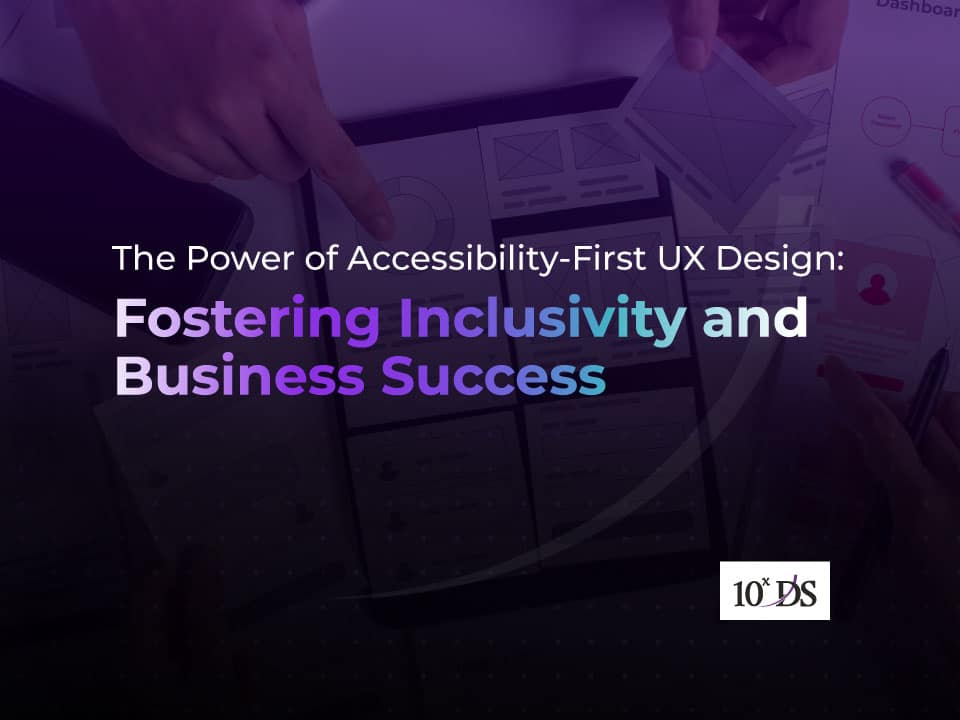
The Power of Accessibility-First UX Design: Fostering Inclusivity and Business Success
In the world of user experience (UX) design, putting users at the centre is paramount. Accessibility-first design takes this principle to the next level by prioritizing inclusivity and ensuring that digital products cater to all individuals, including those with special needs physically and mentally. Understanding the importance of accessibility in UX design can lead to increased customer satisfaction, improved brand loyalty, and reduced costs. In this blog post, we’ll delve into the significance of accessibility-first design, the challenges faced by UX designers, and the best practices to create products that enrich the lives of all users.
The Impact of Accessibility-First Design
UX design is all about crafting experiences that evoke specific emotions and encourage desired behaviours in users. Accessibility-first design extends this focus by empathizing with users and identifying potential gaps in their experience. According to the World Health Organization (WHO), approximately 1.3 billion people worldwide experience significant disability. Ignoring these numbers is not an option. For an inclusive UX journey, accessibility should be prioritized from the beginning of project processes, even during user research. Neglecting accessibility can lead to difficulties in retrofitting it later, like compromising the user experience as well as adding cost. Incorporating accessibility in testing protocols is a minimum requirement, but successful designs demand early and informed decisions.
The Universal Design Approach
Accessibility evaluates products from the perspective of whether people with diverse abilities can effortlessly use them. No user should feel ostracized because of a disability. A logical navigation system ensures a consistent user experience for all. An accessible user interface (UI) expands coverage, enabling as many people as possible to understand, navigate, and interact with digital products seamlessly. The concept of universal design embodies accessibility, aiming to create “one size fits all” solutions for users regardless of their physical or mental condition. By adopting this approach, UX designers can create experiences that benefit everyone, from those with permanent disabilities to individuals with temporary impairments or situational difficulties, such as seniors lacking digital knowledge.
Example: Senior Citizens’ Difficulties in Accessing Digital Products.
The accessibility challenges faced by seniors, who represent one of the fastest-growing demographics on the web, cannot be overlooked. Many websites and apps are hard for seniors to use, as usability studies from Nielsen Norman Group, a well-known UX research and consulting firm, reveal. Elements like dropdowns and sliders can be particularly difficult for users with declining motor skills, especially on touch interfaces. Additionally, non-intuitive user flows and unclear instructions can make a product inaccessible for certain groups of people, including seniors. To create a truly inclusive experience, UX designers need to consider the needs and limitations of all users and implement design solutions that cater to their unique requirements.
Standards and Guidelines on Web and App Accessibility
In 2006, the National Federation of the Blind filed a lawsuit against ‘Target’, an American retail corporation, due to its inaccessible website. Target paid a hefty six-million-dollar fine and committed to making their website accessible to people with disabilities. The importance of accessibility has been highlighted further with an increase in accessibility lawsuits in 2017. For UX designers, there are two major sets of accessibility guidelines in the United States: WCAG and Section 508. WCAG sets world-accepted standards for website and app accessibility, focusing on perceivability, operability, understandability, and robustness. Section 508 is specifically for governmental projects, ensuring legal compliance with accessibility guidelines, while for private sector projects, adherence to WCAG is recommended.
Challenges Faced by UX Designers
While accessibility-first design offers immense benefits, it also comes with challenges. UX designers must recognize and understand indirect design biases, develop designs for diverse target audiences, and empathize with users with impairments. Knowledge about the limitations and abilities of people with disabilities is essential. Implementing accessibility features may increase design costs and incorporating them into existing software can be technically challenging. However, addressing these challenges is crucial to ensuring an inclusive user experience.
Best Practices for Accessibility-First UX Design
To create unbiased tech designs, UX designers should conduct usability tests from various perspectives, overcoming personal biases through audience research. Mobile accessibility is critical, given the significant share of internet traffic from mobile devices. Following the Web Content Accessibility Guidelines (WCAG) enhances inclusive design. Detailed user research, thoughtful structural and content elements, device-independent design, and keyboard accessibility are some of the key best practices to prioritize accessibility in UX design.
Incorporating accessibility-first design principles into UX development not only benefits individuals with disabilities but also boosts customer satisfaction, engagement, and brand loyalty. UX professionals have the responsibility and ability to ensure that everyone can access the products they create, regardless of their abilities, context, or situation. By embracing accessibility-first design, businesses can build a reputation as inclusive and customer-centric brands, setting themselves up for long-term success in a rapidly evolving digital landscape. If you need help creating an inclusive and accessible design, don’t hesitate to reach out. Let’s collaborate to build a better, more inclusive web! Talk to our experts to revamp the user journey experience for your customers.

